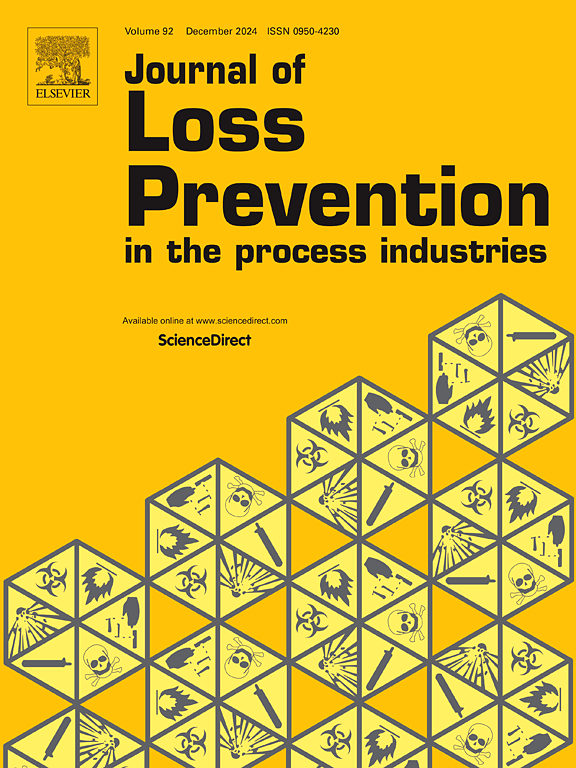Prediction of explosion hazard of aluminum powder two-phase mixed system using random forest based on K-fold cross-validation
IF 3.6
3区 工程技术
Q2 ENGINEERING, CHEMICAL
Journal of Loss Prevention in The Process Industries
Pub Date : 2025-02-01
DOI:10.1016/j.jlp.2025.105574
引用次数: 0
Abstract
Dust explosion is a significant safety hazard in various industries and trades, with aluminum dust being particularly sensitive to ignition and leading to severe explosion consequences. During the actual industrial production process, there is a risk of aluminum powder dust coming into contact with other metal dust, flammable and explosive gases and liquids. Aluminum dust and other flammable and explosive substances, even if the concentration of aluminum dust and other flammable and explosive substances are below the lower explosive limit, the aluminum dust as the dominant multi-phase mixing system still has the potential to explode. Compared to a single aluminum dust, the aluminum powder multiphase system has a higher explosion hazard. Thus, the rapid prediction of the explosion intensity of the gas-liquid-solid multiphase system with aluminum dust as the main body is of great significance for the assessment of the explosion hazard of the mixed dust. On the other hand, the explosion properties of the gas-liquid-solid multiphase system with aluminum powder as the main body are affected by a number of factors such as powder particle size, powder concentration, combustible material concentration, and different systems have a large variability between. This is a significant challenging for the rapid and precise prediction of the explosive intensity of aluminum powders in multiphase systems. In this study, machine learning methods (random forest (RF) and multilayer perceptron (MLP)) were applied to deeply excavate the nonlinear relationship between the explosion index (Kst) of gas-liquid-solid multiphase system with aluminum dust as the main body and the explosion influencing factors. Feature engineering was employed during the model building process for improving the data representation model. The grid search method, including the K-fold cross-validation and three-model performance evaluation metrics, were incorporated to optimize, assess, and test the model's state and performance. A total of 233 Kst samples were gathered, with 163 samples (70% of the total samples) were allocated for training while the other 70 samples (30% of the total samples) were adopted for testing. By adopting the same dataset, compared with the MLP model, the RF model exhibits enhanced generalization capability and higher prediction accuracy, with a prediction accuracy of about 90%. Furthermore, the gas-solid two-phase dominated by aluminum powder had the highest prediction accuracy in the RF model, followed by liquid-solid and solid-solid systems. This study could help to rapidly predict the explosion intensity of the multi-phase system of aluminum powder occurring under complex conditions, and paved a way for decision-making of multi-factor affected emergency.
基于K-fold交叉验证的随机森林预测铝粉两相混合系统的爆炸危险性
粉尘爆炸是各行业重大的安全隐患,其中铝粉尘极易着火,爆炸后果严重。在实际工业生产过程中,铝粉粉尘存在与其他金属粉尘、易燃易爆气体和液体接触的危险。铝尘和其他易燃易爆物质,即使铝尘和其他易燃易爆物质的浓度低于爆炸下限,以铝尘为主导的多相混合系统仍有爆炸的可能。与单一铝粉相比,铝粉多相体系具有更高的爆炸危险性。因此,快速预测以铝粉尘为主体的气液固多相体系的爆炸强度,对混合粉尘的爆炸危险性评价具有重要意义。另一方面,以铝粉为主体的气液固多相体系的爆炸性能受到粉末粒度、粉末浓度、可燃物浓度等诸多因素的影响,不同体系之间存在较大的可变性。这对多相体系中铝粉爆炸强度的快速准确预测是一个重大的挑战。本研究采用随机森林(random forest, RF)和多层感知器(multilayer perceptron, MLP)等机器学习方法,深入挖掘以铝粉为主体的气液固多相体系爆炸指数(Kst)与爆炸影响因素之间的非线性关系。在模型构建过程中采用特征工程对数据表示模型进行改进。结合网格搜索方法,包括K-fold交叉验证和三模型性能评估指标,对模型的状态和性能进行优化、评估和测试。共收集到233个Kst样本,其中163个样本(占总样本的70%)用于训练,另外70个样本(占总样本的30%)用于测试。在采用相同数据集的情况下,与MLP模型相比,RF模型具有更强的泛化能力和更高的预测精度,预测精度约为90%。在RF模型中,以铝粉为主的气固两相预测精度最高,其次是液-固和固-固体系。该研究有助于快速预测复杂条件下铝粉多相体系的爆炸强度,为多因素影响的应急决策铺平道路。
本文章由计算机程序翻译,如有差异,请以英文原文为准。
求助全文
约1分钟内获得全文
求助全文
来源期刊
CiteScore
7.20
自引率
14.30%
发文量
226
审稿时长
52 days
期刊介绍:
The broad scope of the journal is process safety. Process safety is defined as the prevention and mitigation of process-related injuries and damage arising from process incidents involving fire, explosion and toxic release. Such undesired events occur in the process industries during the use, storage, manufacture, handling, and transportation of highly hazardous chemicals.

 求助内容:
求助内容: 应助结果提醒方式:
应助结果提醒方式:


